A promising new way to inhibit cholesterol production in the body, one that may yield treatments as effective as existing medications but with fewer side-effects has been discovered by scientists

SM is one of at least 20 enzymes involved in the assembly line when cholesterol is made throughout the body but only one - HMG-CoA reductase (HMGR) - is currently targeted by medications to lower cholesterol levels in the blood.
"The class of drugs most commonly used to lower cholesterol - statins - are the blockbusters of the pharmaceutical world and work by inhibiting HMGR," says Professor Brown.
"But HMGR is involved very early on in the assembly line, so inhibiting it affects all the other steps down the line - and other useful products it provides - and that can give rise in some people to unwanted side-effects, such as muscle pain.
"What's exciting about this previously overlooked SM enzyme is that it acts as a checkpoint much further down the assembly line, which should mean that it can be more specifically targeted at cholesterol production instead and leave the early part of the assembly line undisturbed.
"Cholesterol has developed something of a bad name, so many people don't realise that it is actually essential for a healthy body. It's needed, for example, to make sex hormones and to help build the walls of every single cell in our bodies."
Advertisement
Professor Brown likens this process to the water supply to a home: water is essential but careful control is needed for how and where it is delivered and at what rate.
Advertisement
As it happens, medications already widely used for treating fungal infections have been shown to work by inhibiting the fungal enzyme equivalent of SM. Anti-cholesterol drugs that target SM for human use still need to be tested.
The study has been published in the journal Cell Metabolism.
Source-ANI














